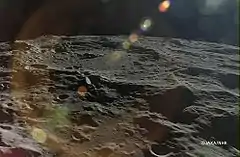Drygalski (crater)
Drygalski is a large lunar impact crater that lies along the southern limb of the Moon. It partly overlies the crater Ashbrook to the west on the far side of the Moon. Just to the north of Drygalski is the smaller Boltzmann. The location of this crater restricts its observation from the Earth, and even under conditions of favorable libration it is viewed from the edge. It is only illuminated by the Sun at an oblique angle, and it lies close to the south polar craters that are permanently shielded from sunlight.
 Clementine mosaic | |
| Coordinates | 79.3°S 84.9°W |
|---|---|
| Diameter | 149 km |
| Depth | 4.0 km |
| Colongitude | 102° at sunrise |
| Eponym | Erich D. Von Drygalski |


The outer rim of this crater has been worn and eroded by subsequent impacts, leaving a rugged, mountainous ring that is overlaid in places by small craters. The most notable of these are Drygalski P across the southwest rim where it joins Ashbrook, and Drygalski V along the north-northwest inner wall. There is a small catena, or crater chain, beginning tangentially the northern outer rim then arcing to the north towards Boltzmann. To the south is an odd formation of two or more small craters, forming a short valley.
Portions of the interior floor within the inner walls is flat and level, having been resurfaced by lava. The flattest parts are in the southern and eastern sections of the interior. The surface is more rugged in the west, and is marked by several small craterlets. At the midpoint of the interior is a rugged central peak formation with several smaller ridges along the flanks.
Satellite craters
By convention these features are identified on lunar maps by placing the letter on the side of the crater midpoint that is closest to Drygalski.
| Drygalski | Latitude | Longitude | Diameter |
|---|---|---|---|
| P | 81.0° S | 99.9° W | 30 km |
| V | 78.5° S | 93.4° W | 21 km |
The following craters have been renamed by the IAU.
- Drygalski Q — See Ashbrook.
References
- Andersson, L. E.; Whitaker, E. A. (1982). NASA Catalogue of Lunar Nomenclature. NASA RP-1097.
- Blue, Jennifer (July 25, 2007). "Gazetteer of Planetary Nomenclature". USGS. Retrieved 2007-08-05.
- Bussey, B.; Spudis, P. (2004). The Clementine Atlas of the Moon. New York: Cambridge University Press. ISBN 978-0-521-81528-4.
- Cocks, Elijah E.; Cocks, Josiah C. (1995). Who's Who on the Moon: A Biographical Dictionary of Lunar Nomenclature. Tudor Publishers. ISBN 978-0-936389-27-1.
- McDowell, Jonathan (July 15, 2007). "Lunar Nomenclature". Jonathan's Space Report. Retrieved 2007-10-24.
- Menzel, D. H.; Minnaert, M.; Levin, B.; Dollfus, A.; Bell, B. (1971). "Report on Lunar Nomenclature by the Working Group of Commission 17 of the IAU". Space Science Reviews. 12 (2): 136–186. Bibcode:1971SSRv...12..136M. doi:10.1007/BF00171763. S2CID 122125855.
- Moore, Patrick (2001). On the Moon. Sterling Publishing Co. ISBN 978-0-304-35469-6.
- Price, Fred W. (1988). The Moon Observer's Handbook. Cambridge University Press. ISBN 978-0-521-33500-3.
- Rükl, Antonín (1990). Atlas of the Moon. Kalmbach Books. ISBN 978-0-913135-17-4.
- Webb, Rev. T. W. (1962). Celestial Objects for Common Telescopes (6th revised ed.). Dover. ISBN 978-0-486-20917-3.
- Whitaker, Ewen A. (1999). Mapping and Naming the Moon. Cambridge University Press. ISBN 978-0-521-62248-6.
- Wlasuk, Peter T. (2000). Observing the Moon. Springer. ISBN 978-1-85233-193-1.
